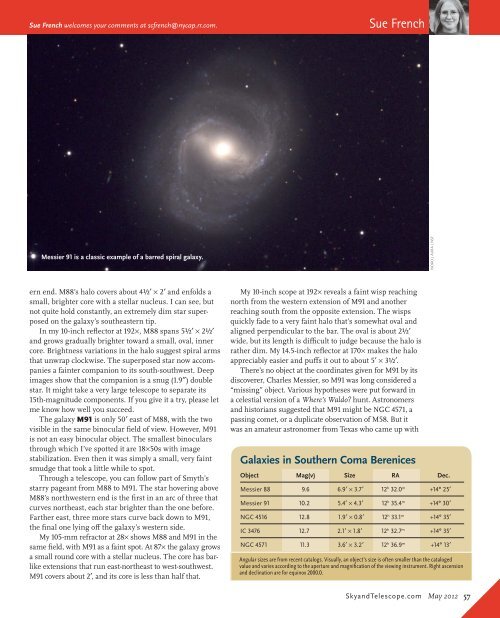Download this ebook as PDF - E-Book Library
Download this ebook as PDF - E-Book Library
Download this ebook as PDF - E-Book Library
Create successful ePaper yourself
Turn your PDF publications into a flip-book with our unique Google optimized e-Paper software.
Sue French welcomes your comments at scfrench@nycap.rr.com.<br />
Messier 91 is a cl<strong>as</strong>sic example of a barred spiral galaxy.<br />
ern end. M88’s halo covers about 4½′ × 2′ and enfolds a<br />
small, brighter core with a stellar nucleus. I can see, but<br />
not quite hold constantly, an extremely dim star superposed<br />
on the galaxy’s southe<strong>as</strong>tern tip.<br />
In my 10-inch refl ector at 192×, M88 spans 5½′ × 2½′<br />
and grows gradually brighter toward a small, oval, inner<br />
core. Brightness variations in the halo suggest spiral arms<br />
that unwrap clockwise. The superposed star now accompanies<br />
a fainter companion to its south-southwest. Deep<br />
images show that the companion is a snug (1.9″) double<br />
star. It might take a very large telescope to separate its<br />
15th-magnitude components. If you give it a try, ple<strong>as</strong>e let<br />
me know how well you succeed.<br />
The galaxy M91 is only 50′ e<strong>as</strong>t of M88, with the two<br />
visible in the same binocular fi eld of view. However, M91<br />
is not an e<strong>as</strong>y binocular object. The smallest binoculars<br />
through which I’ve spotted it are 18×50s with image<br />
stabilization. Even then it w<strong>as</strong> simply a small, very faint<br />
smudge that took a little while to spot.<br />
Through a telescope, you can follow part of Smyth’s<br />
starry pageant from M88 to M91. The star hovering above<br />
M88’s northwestern end is the fi rst in an arc of three that<br />
curves northe<strong>as</strong>t, each star brighter than the one before.<br />
Farther e<strong>as</strong>t, three more stars curve back down to M91,<br />
the fi nal one lying off the galaxy’s western side.<br />
My 105-mm refractor at 28× shows M88 and M91 in the<br />
same fi eld, with M91 <strong>as</strong> a faint spot. At 87× the galaxy grows<br />
a small round core with a stellar nucleus. The core h<strong>as</strong> barlike<br />
extensions that run e<strong>as</strong>t-northe<strong>as</strong>t to west-southwest.<br />
M91 covers about 2′, and its core is less than half that.<br />
Sue French<br />
My 10-inch scope at 192× reveals a faint wisp reaching<br />
north from the western extension of M91 and another<br />
reaching south from the opposite extension. The wisps<br />
quickly fade to a very faint halo that’s somewhat oval and<br />
aligned perpendicular to the bar. The oval is about 2½′<br />
wide, but its length is diffi cult to judge because the halo is<br />
rather dim. My 14.5-inch refl ector at 170× makes the halo<br />
appreciably e<strong>as</strong>ier and puff s it out to about 5′ × 3½′.<br />
There’s no object at the coordinates given for M91 by its<br />
discoverer, Charles Messier, so M91 w<strong>as</strong> long considered a<br />
“missing” object. Various hypotheses were put forward in<br />
a celestial version of a Where’s Waldo? hunt. Astronomers<br />
and historians suggested that M91 might be NGC 4571, a<br />
p<strong>as</strong>sing comet, or a duplicate observation of M58. But it<br />
w<strong>as</strong> an amateur <strong>as</strong>tronomer from Tex<strong>as</strong> who came up with<br />
Galaxies in Southern Coma Berenices<br />
Object Mag(v) Size RA Dec.<br />
Messier 88 9.6 6.9′ × 3.7′ 12 h 32.0 m +14° 25′<br />
Messier 91 10.2 5.4′ × 4.3′ 12 h 35.4 m +14° 30′<br />
NGC 4516 12.8 1.9′ × 0.8′ 12 h 33.1 m +14° 35′<br />
IC 3476 12.7 2.1′ × 1.8′ 12 h 32.7 m +14° 35′<br />
NGC 4571 11.3 3.6′ × 3.2′ 12 h 36.9 m +14° 13′<br />
Angular sizes are from recent catalogs. Visually, an object’s size is often smaller than the cataloged<br />
value and varies according to the aperture and magnifi cation of the viewing instrument. Right <strong>as</strong>cension<br />
and declination are for equinox 2000.0.<br />
SkyandTelescope.com May 2012 57<br />
NOAO / AURA / NSF


